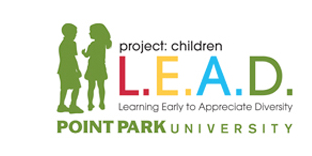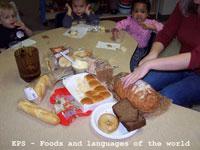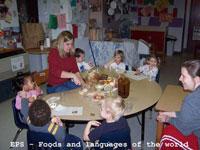Lesson 2: Early Pre-School (Ages 2-3) Foods and Language Lesson Series

Project: LEAD | Curriculum | Resources | Workshops | Activities | About Us
Foods and Languages of the World
Teachers: Sara Conway, Barbara Geary, Joy Evans
Project Children L.E.A.D. Director: Dr. Vincenne Revilla Beltran
Subject Area: Diversity
Grade level: Early Pre-School (Ages 2-3)
Length of Lesson: 20 minutes
Learning Goals Based on the Pennsylvania Academic Standards and High Scope Key Experiences
Key Experiences
-
Sense of Self
-
Social Relations

-
Creative Representation
-
Movement
-
Music
-
Exploring Objects
-
Number
-
Time
Standards
-
2.63 Children are provided varied learning opportunities that foster positive identity and an emerging sense of self and others.
-
2.75 Children are provided varied opportunities and materials to build their understanding of diversity in culture, family structure, ability, language, age, and gender in non-stereotypical ways.
-
2.84 Infants and toddlers have multiple opportunities to develop fine motor skills by acting on their environments using their hands and fingers in a variety of age-appropriate ways.
-
2.90 Children are provided opportunities and materials to help them learn about nutrition, including sources of food and recognizing, preparing, eating, and valuing healthy foods.
Objectives
-
The children will be able to recognize different types of bread that people eat in different countries of the world.
-
The children will be able to explore and notice how the different foods are the same but different.
-
The children will be exposed to cultural differences in smells and foods.
Materials and Equipment Needed
Books:
- Everybody Bakes Bread by Norah Dooley, Peter J. Thornton (Illustrator)
- Everybody Cooks Rice by Norah Dooley, Peter J. Thornton (Illustrator)
Activity One
- Six clear plastic jars of varying size with lids
- Duplicate pictures of exotic fruit
- Teacher glue
Activity Two
- Bread from different cultures
Baguette
Pene Boule
Old World Tuscany
Danish Style Pumpernickel
Bagel
Pita bread
Sunflower
Hawaiian
- Pictures of all bread sampled
- World map
Procedure
Before completing the activities, the teacher will read the books listed above.
Activity One
-
The teacher will glue one of the fruit pictures on the jar and the other inside the lid. On the jar will also be the name and the flag of the country where the fruit came from.
-
The teacher will set out the six jars and give the children the opportunity to visually and physically examine them.
-
The teacher will model how to twist the jar and compare the pictures.
-
The teacher will engage the children in conversation about the origin and names of the different foods.
Activity Two
-
During snack time, the types of bread listed above will be sampled by the children
-
As the children are sampling the bread, the teacher will describe the bread's appearance, then name the country in which the bread comes from
-
Pictures of the bread will be taken.
-
The bread pictures will then be placed on the world map hanging in the room on the country of origin
These items will be added to centers around the room
- Foods from many cultures in housekeeping
Mexican
Chinese
Review
The children enjoyed tasting the different types of bread. Placing the bread on the world map puts things into perspective for them. Asking the children follow up questions such as: "Which bread was your favorite?"' or "Which bread didn't you like?" add a nice review to the activity. After tasting the bread in the housekeeping area, the children looked and served one another the baguette calling it by name. Having the jars available to the children for a week or longer will be beneficial to the children. They will begin to recognize and learn the different fruit.
Resources
Hall, Nadia Saderman. (1998). Creative Resources for the Anti-Bias Classroom. New York: Delmar Publishers.

